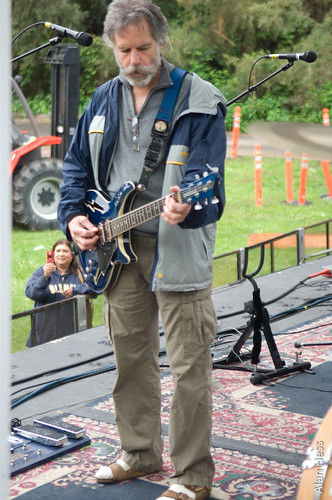And another something on the UCSC GD archive deal
this one is from today and was found at: http://www.cityonahillpress.com/article.php?id=1216
Deadhead Legacy Was Built to Last
May 1, 2008
Deadhead students rejoiced at the recent addition to UC Santa Cruz’s McHenry Library: An archived collection of the Grateful Dead’s photographs, letters, artwork, newspaper clippings, posters, and backstage passes from over three decades of touring.
Soon after, they got back to their astrophysics assignments.
UCSC and the Grateful Dead practically have the same roots and parallel stalks: Both stemmed from the West Coast in 1965, both have reached acclaim for their bohemian atmosphere, and both have national prestige. Yet only one of these is attempting to change their image after over 30 years of embracing a unique counterculture.
Chancellor George Blumenthal stated recently that we are outgrowing our image from the 1970s. But, with the inauguration of Dead Central, it seems as though we can’t outrun the offbeat and informal reputation that our predecessors set when UCSC was just a small liberal-arts university in the woods.
Sure, there was a time that UCSC wasn’t taken seriously, procuring nicknames such as “Tie-Dye High” and “Uncle Charlie’s Summer Camp.” For a university that is more closely related to the Age of Aquarius than the Information Age, most of those who attended UCSC during that time did not mind. In fact, alumni embraced the counterculture that this university represented, and in many ways, we still do.
Our new-and-improved McHenry Library already houses the compilations of science fiction writer Robert A. Heinlein, who is best known for his works championing sexual liberation, free love and individualism. Beat poet, painter, pacifist, and novelist Kenneth Patchen, also known as the Proletariat Poet, is archived within the cement walls of the library, joining the only intact collection of photographer Edward Weston’s project prints in the world. If those walls could talk, they would talk about love, self-definition, experimentation, and peace: not expansion, physics, and fiscal advancement.
Photography darkrooms are turning into digital computer labs, music is now spawned from a synthesizer, and libraries are being stored in online references as we lurch into the technological age. Old art forms are made new with the wonders of science, and with the onslaught of advancement, our roots are forgotten in the midst of progress.
In 1997, UCSC switched from the Narrative Evaluation System (NES), a maverick pass-or-fail technique that required professors to give a full report on each student’s progress, to the now-uniform UC grading system, thus giving students the benefit of a grade point average and the eligibility to compete as one of the top-standing students in the nation.
With the demise of NES came the birth of the School of Engineering under Chancellor M.R.C Greenwood. Along with the prestige-hungry administration, Greenwood spurred the cultivation of the electrical engineering, applied mathematics and computer science departments in the hope that our reputation would change.
Despite the noble efforts of Greenwood, Blumenthal and their colleagues to advance UCSC toward a mantra of research — and simultaneously sending it on an ascent to national notoriety — our scarlet letter has remained emblazoned on our chests, which many of us proudly bare.
This present-day notion that the times are changing is not solely expressed through academics and is posing a large inconvenience to the students who still live this counterculture.
Controversy broke when the administration alerted the student body of the new security measures to be taken on April 20. Hundreds of students smuggled friends onto the campus, hiding them within university housing, and marched to Porter Field — joining the thousands who walked to campus from every direction through meadows and dense forests to partake in one of the many time-honored traditions that keeps UCSC on the outskirts of traditional universities. These acts of rebellion serve to solidify the sense of unity, perseverance, activism, free speech and movement on campus; through defiance, the student body was channeling the counterculture of eras past and reaffirming that it isn’t going to be forgotten any time soon.
The powers-that-be should realize that if we want something done, we’ll do it ourselves. It’s the way we’ve always been and how we’ll continue to be; and no powers of the administration or the law can stand in the way when thousands of students are standing in opposition.
According to Grateful Dead member Bob Weir, UCSC was given the collection because the Dead are part of a neo-bohemian culture that still resides in the hills of Santa Cruz. Weir points out that both the Dead and the university “continue to make a major, positive impact on the world.”
The notion of progress and the recent push to be a competitive national university has mass appeal. Yet, no matter how many accolades we receive, forgetting the legacy ingrained in the city of Santa Cruz itself is impossible. Our legacy can be heard in the faculty member’s voices, seen in the graffiti that covers the cement walls, viewed in the art crafted by students, and felt through the student body’s actions toward a future that continues to change for the better.
Despite the administration’s heavy push toward all that is technological and scientific, and their attempts to instill a heavy-felt sense of “order,” it is starting to look like our long-standing reputation is here to stay. After all, it is the students, not the institution, which holds the power to change.
1 week ago






